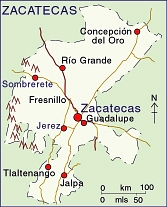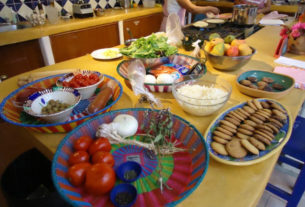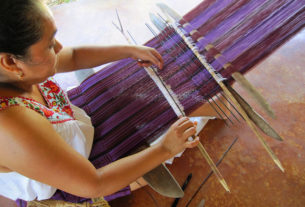
Two sites within an hour’s drive south of Zacatecas make it well worthwhile to linger at least an extra day when visiting this splendid colonial treasure, described in a previous Mexico Connect article. ( Zacatecas) The two sites in question are La Quemada (The Burnt) and Jerez (Sherry).
La Quemada grew into the largest pre-Columbian settlement known in southern Zacatecas. Its original name is unknown; it was christened La Quemada by the early Spaniards who found evidence of a great conflagration.
The modern site museum. opened in 1995, has a scale model showing more than 50 terraces and about 1 km2 of constructions. Occupied from about 200 – 300 AD, its population peaked after 500 AD, before the site was abandoned about 1000 AD, 1000 years ago. The residential elite lived on the edge of the hills.
Most structures originally had a layer of barro (earthenware) and vegetable fibre “plaster”, and were finished with a wash of cal (lime). Both plaster and lime have now been all but eroded away, together with the mud mortar that served to bind the rocks. The site served as an unofficial building supply store for a thousand years, losing perhaps 15% of the original constructions.
Eighteenth century historians conjectured that this might have been the legendary Chicomostoc, through which the Mexica passed on their peregrination from Aztlán to found Tenochtitlan. But the constructions are clearly too extensive, and the quality of architecture too high, for La Quemada to have been only a temporary settlement.
A network of “roads”, built of slabs and clay, extends from La Quemada to some 200 minor sites on the Malpaso valley floor. The site was built at different times, successive stages covering parts of previous constructions. Delimiting the northern part of the site is a great wall, 900 metres long, 3.80 metres high and 3.60 metres wide. The wall suggests a defensive role for La Quemada but the buildings have civic-religious functions. La Quemada is perhaps best described, therefore, as a fortified ceremonial site.
Who were the first settlers here? Little is known about their origins. They may have been migrants or perhaps they were “home-grown”. For a centre of this size, they obviously needed a resource base including ample food supplies. Evidence from the valley floor indicates that they cultivated maize, beans, squash and maguey, and also used amaranth seeds, tomato, nopal leaves and fruit as well as other wild plants.
Trade links must have been very important. Between 500 and 700 A.D., it seems likely that La Quemada had close ties to other key sites, including Chalchihuites to the northwest, then with mining activities never previously equalled anywhere in Mesoamerica. La Quemada apparently became a trade centre for the collection and redistribution of raw materials like salt, minerals, shell etc.
Among advanced construction projects undertaken between 650 and 850 A.D. was the Chamber of Columns, one of the largest roofed structures yet found anywhere in Mesoamerica. Only the columns remain today.
After 850 A.D., La Quemada went into decline, with some residential areas being abandoned and the “Great Wall” being built, presumably for defense. The site was abandoned completely shortly after 900 A.D. Why the decline and abandonment? Did climatic change cause the valley to dry out? Were trade or military conflicts the reason? Perhaps the people who left La Quemada founded the Toltec site of Tula in around 900 A.D.? Whatever the reason, and wherever they went, they left us an enigmatic statement of their prowess as architects, tradespeople and builders.
Much easier to interpret than La Quemada is the undiscovered colonial gem of Jerez. Incredibly, most guidebooks give it no more than a passing mention, if it is even included at all!
Jerez, at an altitude of 2000 metres (6500 feet), was founded in the mid-sixteenth century to help protect the silver trading routes connecting the silver mines of Zacatecas with cities like Guadalajara, from attacks by the “wild” (Charlotte M. Gradie) Chichimeca Indians. In time, the city became known as “The Athens of Zacatecas”, and today is a National Historic Monument where the stones still tell their stories…
Starting from the central plaza, the self-guided walking tour which follows includes many of the major sites. The central plaza is more correctly called the Jardín Rafael Páez. Its wooden, moorish-looking nineteenth century kiosk, has the half-moon of Islam, Star of David and some Roman bells decorating it, presumably symbolizing the union of civilizations.
West of the Garden is the Palacio Municipal (Town Hall). An earlier version was destroyed by fire in 1913 with the loss of valuable archives. The arcade north of the Garden is the Portal Inguanzo, which includes the facade of the house of the wealthy Inguanzo family, owners of El Tesoro Hacienda and an ice-cream store, “El Paraíso”, which displays a selection of old photos of Jerez. Off the north-east corner of the Garden is the sandstone “La Nacional” building. The south arcade is the Portal Humboldt.
A few steps from the Garden is the nineteenth century Santuario de la Soledad sandstone church with twin towers and a lovely main doorway. A stylish fence surrounds its atrium. The main altar is home to the most revered statuette in Jerez.
The elaborate “De La Torre” building across the street has wonderful cedar doors, carved by Severo Revilla, an Indian child abandoned in Jerez after an aborted attack by the “natives”. Revilla was raised and named by the local priest. The building is the work of master stonemason Dámaso Muñetón. Originally a school for girls, it is now the Cultural Institute.
The five arches on the north side of the “Small Garden” or Jardín Hidalgo belong to the Teatro Hinojosa, also built by Muñetón, and architecturally one of Mexico’s finest theatres. Restoration finished in 1987. Its lovely three-tiered interior features a huge central chandelier that had to be regularly lowered to fill its many lanterns with petroleum. A mirror at the back of the theater reflected the chandelier light back onto the stage as a spotlight. If it looks familiar, perhaps it is – because it is supposed to be an exact replica of the Ford Theatre in Washington D.C.
Walking back past the Edificio De La Torre, are several stores selling some handsome crafts and collectibles. A few steps more and we arrive at Plaza Tacuba. On one side is the “doves” doorway, named for two stone doves beak to beak. Legend tells how a century ago, two powerful hacienda owners arranged a marriage between their respective offspring. Mortified, the children did marry but agreed a joint suicide pact which they carried out right here.
Beyond Plaza Tacuba are the eighteenth century parish church of the Immaculate Conception and, hidden behind a newer construction, the museum of Ramón López Velarde (1888-1921), one of Mexico’s leading poets.
If you are lucky enough to visit Jerez during Easter week, then don’t miss the town’s Judas competition, in which competition entries are hung from various places and then set on fire by horseback riders carrying flaming lances.
Maybe most guide books say there’s nothing worth seeing south of Zacatecas, but that only shows that their writers have never been there!



The anti-indigenous sentiments are felt so hard in this written piece. Calling natives “wild indians” is disgraceful. If you are going to tell the story of our country, you should have the decency to show some honor and respect to the original inhabitants of the land. Shameful!
JE, Thank you for pointing out this editing error in the original article, which has now been amended. We appreciate your comment and its sentiment, one with which we entirely agree. Thank you again for helping to improve the content on MexConnect. TB